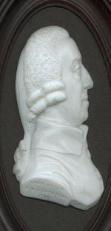Tassie medallions
 Born in Pollokshaws, Tassie originally trained as a stonemason, then studied sculpture and modelling at the Foulis brothers’ Academy of Fine Arts in Glasgow. Together with Dr Henry Quin, he invented a white vitreous paste, a type of lead potash, which became hard and glass-like when fired. Initially, Tassie became hugely successful using his invention to make copies of antique cameos.
Born in Pollokshaws, Tassie originally trained as a stonemason, then studied sculpture and modelling at the Foulis brothers’ Academy of Fine Arts in Glasgow. Together with Dr Henry Quin, he invented a white vitreous paste, a type of lead potash, which became hard and glass-like when fired. Initially, Tassie became hugely successful using his invention to make copies of antique cameos.
Later, the artist specialised in portrait medallions, for which he is best known today. He had a great ability in capturing a likeness and would model from life in red wax. From this he would make a mould which was then filled with the paste and fired. When cooled, it resembled marble or glass, a far sharper result than fired clay, and could be given a matt or highly polished surface. In 1779 he was “modelling some of the finest people in the Kingdom”, the rich, famous and intellectual, who came for two and a half hour sittings, far less time than for a painting.
The Hunterian’s collection of Tassie 'medallions', described by expert Ailsa Boyd, “includes important 18th century Glasgow University Professors such as Thomas Reid, Adam Smith, Joseph Black and William Cullen. Other notable people include Robert Adam, the celebrated Scottish architect, interior designer and property developer who formed the distinctive and highly influential “Adam Style”, merchants and industrialists such as David Dale the philanthropic industrialist who began cotton spinning on a huge scale at New Lanark, and Admiral Lord Viscount Duncan. Born in Dundee, he entered the navy in 1746 and commanded the Blenheim at the relief of Gibraltar in 1782. Duncan became an admiral in 1795 and maintained command of the North Sea Fleet until 1801. After the initial portrait sitting, Tassie was able to reproduce innumerable medallions for sale as mementoes, for as little as five shillings. The one in The Hunterian’s collection, commemorating Admiral Duncan’s admired victory at Camperdown in 1797 during the Napoleonic Wars, was particularly popular”.

